By Saqib Iqbal Ahmed
NEW YORK (Reuters) -The dollar rose against the euro on Thursday after data showed U.S. business activity accelerated to the highest level in just over two years in May, suggesting economic growth is picking up in the middle of the second quarter.
S&P Global said its flash US Composite PMI Output Index, which tracks manufacturing and services sectors, rose to 54.4 this month. That was the highest level since April 2022 and followed a final reading of 51.3 in April.
A reading above 50 indicates expansion in the private sector.
“The currency action shows that the market is still reacting to strong U.S. economic data in the expected way,” said Marc Chandler, chief market strategist at Bannockburn Global Forex LLC.
“I think the dollar has a little more room on the upside,” Chandler said.
Data on Thursday also showed that the number of Americans filing new claims for unemployment benefits fell last week, pointing to an underlying strength in the labor market that should continue to support the economy.
Federal Reserve officials said at their latest policy meeting that they were still confident that price pressures would at least slowly ease over the coming months, but doubts emerged about whether current interest rate levels were high enough to guarantee that outcome . would be prepared to raise borrowing costs again if inflation were to rise sharply.
“Given the FOMC comments, the market is still overstating the chances of two rate cuts this year,” Chandler said, noting that tapering the rate cuts would keep the dollar supported in the near term.
The euro fell 0.2% to $1.080525. The common currency rose to $1.0861 earlier in the session after the preliminary composite Purchasing Managers’ Index for the currency bloc rose above the 50 level for the third straight month, separating growth from contraction, with even struggling manufacturing seeing a recovery showed.
Better-than-feared economic data in recent months helped the euro rise in April and early May, and Thursday’s data pushed the currency back to a two-month high in mid-May at $1.0895.
“The EU PMI numbers have put some pressure on the stagflation theme, but it still feels a bit like stagflation ‘light’, if you will, and we need to see more on the growth side of that,” said Brad Bechtel, global head of FX at Jefferies, said in a note.
The pound fell 0.2% to $1.2689 against the dollar. Prime Minister Rishi Sunak called a national election on Wednesday, with his Conservatives widely expected to lose to the opposition Labor party after 14 years in power. However, sterling volatility has increased in the period surrounding the July 4 election. [GBP/]
“The market is quite confident that there will be a Labor government, and it is also quite confident that the Labor government will not be all that different in terms of fiscal policy from the current mix of Sunak and (minister of Finance Jeremy) Hunt,” he said. Jane Foley, head of FX strategy at Rabobank.
The dollar was 0.1% higher against the Japanese currency at 156.91 yen after data showed Japanese factory activity expanded for the first time in a year in May.
Japan’s corporate sector has been hit by the weak yen, with nearly half of Japanese companies feeling that the yen’s decline above 155 against the dollar is hurting their business, roughly double the percentage of those who view the currency’s weakness as positive, according to Reuters. Research showed Thursday.
The New Zealand dollar fell 0.1% to $0.60925 after data released on Thursday showed retail sales in New Zealand rose unexpectedly. back when it expects to make cuts. {AUD/]

Among cryptocurrencies, ether rose 1% to $3,776 after rising to $3,945.50, its highest level since mid-March.
It has soared amid speculation about the possible approval of US spot exchange-traded funds that would track the world’s second-largest cryptocurrency.


